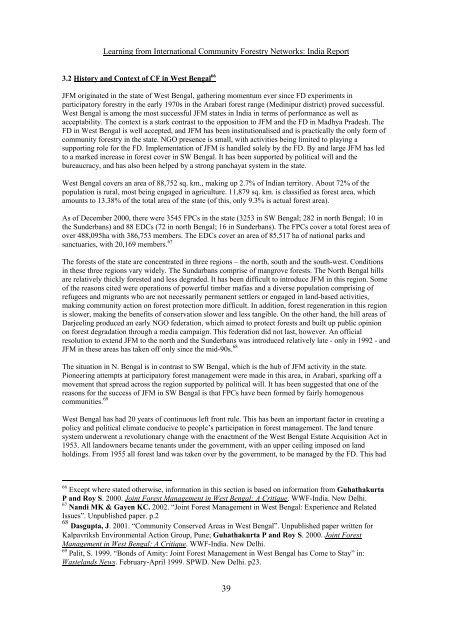Snapshots of International Community Forestry Networks: Country ...
Snapshots of International Community Forestry Networks: Country ...
Snapshots of International Community Forestry Networks: Country ...
Create successful ePaper yourself
Turn your PDF publications into a flip-book with our unique Google optimized e-Paper software.
Learning from <strong>International</strong> <strong>Community</strong> <strong>Forestry</strong> <strong>Networks</strong>: India Report<br />
3.2 History and Context <strong>of</strong> CF in West Bengal 66<br />
JFM originated in the state <strong>of</strong> West Bengal, gathering momentum ever since FD experiments in<br />
participatory forestry in the early 1970s in the Arabari forest range (Medinipur district) proved successful.<br />
West Bengal is among the most successful JFM states in India in terms <strong>of</strong> performance as well as<br />
acceptability. The context is a stark contrast to the opposition to JFM and the FD in Madhya Pradesh. The<br />
FD in West Bengal is well accepted, and JFM has been institutionalised and is practically the only form <strong>of</strong><br />
community forestry in the state. NGO presence is small, with activities being limited to playing a<br />
supporting role for the FD. Implementation <strong>of</strong> JFM is handled solely by the FD. By and large JFM has led<br />
to a marked increase in forest cover in SW Bengal. It has been supported by political will and the<br />
bureaucracy, and has also been helped by a strong panchayat system in the state.<br />
West Bengal covers an area <strong>of</strong> 88,752 sq. km., making up 2.7% <strong>of</strong> Indian territory. About 72% <strong>of</strong> the<br />
population is rural, most being engaged in agriculture. 11,879 sq. km. is classified as forest area, which<br />
amounts to 13.38% <strong>of</strong> the total area <strong>of</strong> the state (<strong>of</strong> this, only 9.3% is actual forest area).<br />
As <strong>of</strong> December 2000, there were 3545 FPCs in the state (3253 in SW Bengal; 282 in north Bengal; 10 in<br />
the Sunderbans) and 88 EDCs (72 in north Bengal; 16 in Sunderbans). The FPCs cover a total forest area <strong>of</strong><br />
over 488,095ha with 386,753 members. The EDCs cover an area <strong>of</strong> 85,517 ha <strong>of</strong> national parks and<br />
sanctuaries, with 20,169 members. 67<br />
The forests <strong>of</strong> the state are concentrated in three regions – the north, south and the south-west. Conditions<br />
in these three regions vary widely. The Sundarbans comprise <strong>of</strong> mangrove forests. The North Bengal hills<br />
are relatively thickly forested and less degraded. It has been difficult to introduce JFM in this region. Some<br />
<strong>of</strong> the reasons cited were operations <strong>of</strong> powerful timber mafias and a diverse population comprising <strong>of</strong><br />
refugees and migrants who are not necessarily permanent settlers or engaged in land-based activities,<br />
making community action on forest protection more difficult. In addition, forest regeneration in this region<br />
is slower, making the benefits <strong>of</strong> conservation slower and less tangible. On the other hand, the hill areas <strong>of</strong><br />
Darjeeling produced an early NGO federation, which aimed to protect forests and built up public opinion<br />
on forest degradation through a media campaign. This federation did not last, however. An <strong>of</strong>ficial<br />
resolution to extend JFM to the north and the Sunderbans was introduced relatively late - only in 1992 - and<br />
JFM in these areas has taken <strong>of</strong>f only since the mid-90s. 68<br />
The situation in N. Bengal is in contrast to SW Bengal, which is the hub <strong>of</strong> JFM activity in the state.<br />
Pioneering attempts at participatory forest management were made in this area, in Arabari, sparking <strong>of</strong>f a<br />
movement that spread across the region supported by political will. It has been suggested that one <strong>of</strong> the<br />
reasons for the success <strong>of</strong> JFM in SW Bengal is that FPCs have been formed by fairly homogenous<br />
communities. 69<br />
West Bengal has had 20 years <strong>of</strong> continuous left front rule. This has been an important factor in creating a<br />
policy and political climate conducive to people’s participation in forest management. The land tenure<br />
system underwent a revolutionary change with the enactment <strong>of</strong> the West Bengal Estate Acquisition Act in<br />
1953. All landowners became tenants under the government, with an upper ceiling imposed on land<br />
holdings. From 1955 all forest land was taken over by the government, to be managed by the FD. This had<br />
66<br />
Except where stated otherwise, information in this section is based on information from Guhathakurta<br />
P and Roy S. 2000. Joint Forest Management in West Bengal: A Critique. WWF-India. New Delhi.<br />
67<br />
Nandi MK & Gayen KC. 2002. “Joint Forest Management in West Bengal: Experience and Related<br />
Issues”. Unpublished paper. p.2<br />
68<br />
Dasgupta, J. 2001. “<strong>Community</strong> Conserved Areas in West Bengal”. Unpublished paper written for<br />
Kalpavriksh Environmental Action Group, Pune; Guhathakurta P and Roy S. 2000. Joint Forest<br />
Management in West Bengal: A Critique. WWF-India. New Delhi.<br />
69<br />
Palit, S. 1999. “Bonds <strong>of</strong> Amity: Joint Forest Management in West Bengal has Come to Stay” in:<br />
Wastelands News. February-April 1999. SPWD. New Delhi. p23.<br />
39

















![CynefinFramework final [Read-Only]](https://img.yumpu.com/19017304/1/190x135/cynefinframework-final-read-only.jpg?quality=85)